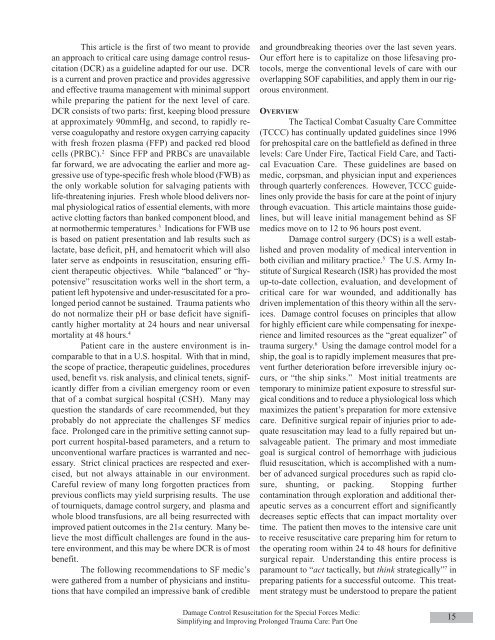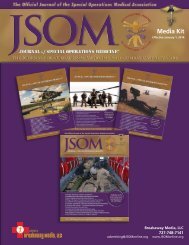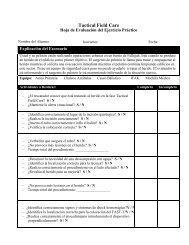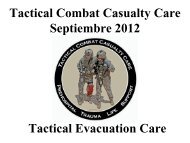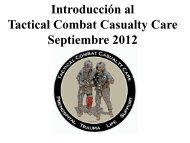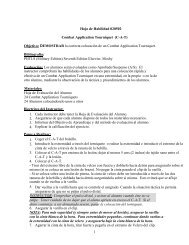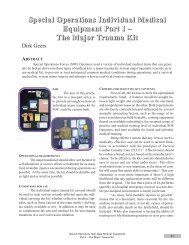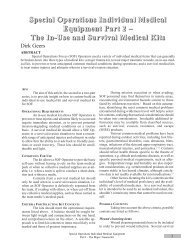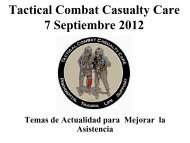Risk G. Hetzler M. Damage Control Resuscitation for the Special ...
Risk G. Hetzler M. Damage Control Resuscitation for the Special ...
Risk G. Hetzler M. Damage Control Resuscitation for the Special ...
Create successful ePaper yourself
Turn your PDF publications into a flip-book with our unique Google optimized e-Paper software.
This article is <strong>the</strong> first of two meant to provide<br />
an approach to critical care using damage control resuscitation<br />
(DCR) as a guideline adapted <strong>for</strong> our use. DCR<br />
is a current and proven practice and provides aggressive<br />
and effective trauma management with minimal support<br />
while preparing <strong>the</strong> patient <strong>for</strong> <strong>the</strong> next level of care.<br />
DCR consists of two parts: first, keeping blood pressure<br />
at approximately 90mmHg, and second, to rapidly reverse<br />
coagulopathy and restore oxygen carrying capacity<br />
with fresh frozen plasma (FFP) and packed red blood<br />
cells (PRBC). 2 Since FFP and PRBCs are unavailable<br />
far <strong>for</strong>ward, we are advocating <strong>the</strong> earlier and more aggressive<br />
use of type-specific fresh whole blood (FWB) as<br />
<strong>the</strong> only workable solution <strong>for</strong> salvaging patients with<br />
life-threatening injuries. Fresh whole blood delivers normal<br />
physiological ratios of essential elements, with more<br />
active clotting factors than banked component blood, and<br />
at normo<strong>the</strong>rmic temperatures. 3 Indications <strong>for</strong> FWB use<br />
is based on patient presentation and lab results such as<br />
lactate, base deficit, pH, and hematocrit which will also<br />
later serve as endpoints in resuscitation, ensuring efficient<br />
<strong>the</strong>rapeutic objectives. While “balanced” or “hypotensive”<br />
resuscitation works well in <strong>the</strong> short term, a<br />
patient left hypotensive and under-resuscitated <strong>for</strong> a prolonged<br />
period cannot be sustained. Trauma patients who<br />
do not normalize <strong>the</strong>ir pH or base deficit have significantly<br />
higher mortality at 24 hours and near universal<br />
mortality at 48 hours. 4<br />
Patient care in <strong>the</strong> austere environment is incomparable<br />
to that in a U.S. hospital. With that in mind,<br />
<strong>the</strong> scope of practice, <strong>the</strong>rapeutic guidelines, procedures<br />
used, benefit vs. risk analysis, and clinical tenets, significantly<br />
differ from a civilian emergency room or even<br />
that of a combat surgical hospital (CSH). Many may<br />
question <strong>the</strong> standards of care recommended, but <strong>the</strong>y<br />
probably do not appreciate <strong>the</strong> challenges SF medics<br />
face. Prolonged care in <strong>the</strong> primitive setting cannot support<br />
current hospital-based parameters, and a return to<br />
unconventional warfare practices is warranted and necessary.<br />
Strict clinical practices are respected and exercised,<br />
but not always attainable in our environment.<br />
Careful review of many long <strong>for</strong>gotten practices from<br />
previous conflicts may yield surprising results. The use<br />
of tourniquets, damage control surgery, and plasma and<br />
whole blood transfusions, are all being resurrected with<br />
improved patient outcomes in <strong>the</strong> 21st century. Many believe<br />
<strong>the</strong> most difficult challenges are found in <strong>the</strong> austere<br />
environment, and this may be where DCR is of most<br />
benefit.<br />
The following recommendations to SF medic’s<br />
were ga<strong>the</strong>red from a number of physicians and institutions<br />
that have compiled an impressive bank of credible<br />
and groundbreaking <strong>the</strong>ories over <strong>the</strong> last seven years.<br />
Our ef<strong>for</strong>t here is to capitalize on those lifesaving protocols,<br />
merge <strong>the</strong> conventional levels of care with our<br />
overlapping SOF capabilities, and apply <strong>the</strong>m in our rigorous<br />
environment.<br />
OVERVIEW<br />
The Tactical Combat Casualty Care Committee<br />
(TCCC) has continually updated guidelines since 1996<br />
<strong>for</strong> prehospital care on <strong>the</strong> battlefield as defined in three<br />
levels: Care Under Fire, Tactical Field Care, and Tactical<br />
Evacuation Care. These guidelines are based on<br />
medic, corpsman, and physician input and experiences<br />
through quarterly conferences. However, TCCC guidelines<br />
only provide <strong>the</strong> basis <strong>for</strong> care at <strong>the</strong> point of injury<br />
through evacuation. This article maintains those guidelines,<br />
but will leave initial management behind as SF<br />
medics move on to 12 to 96 hours post event.<br />
<strong>Damage</strong> control surgery (DCS) is a well established<br />
and proven modality of medical intervention in<br />
both civilian and military practice. 5 The U.S. Army Institute<br />
of Surgical Research (ISR) has provided <strong>the</strong> most<br />
up-to-date collection, evaluation, and development of<br />
critical care <strong>for</strong> war wounded, and additionally has<br />
driven implementation of this <strong>the</strong>ory within all <strong>the</strong> services.<br />
<strong>Damage</strong> control focuses on principles that allow<br />
<strong>for</strong> highly efficient care while compensating <strong>for</strong> inexperience<br />
and limited resources as <strong>the</strong> “great equalizer” of<br />
trauma surgery. 6 Using <strong>the</strong> damage control model <strong>for</strong> a<br />
ship, <strong>the</strong> goal is to rapidly implement measures that prevent<br />
fur<strong>the</strong>r deterioration be<strong>for</strong>e irreversible injury occurs,<br />
or “<strong>the</strong> ship sinks.” Most initial treatments are<br />
temporary to minimize patient exposure to stressful surgical<br />
conditions and to reduce a physiological loss which<br />
maximizes <strong>the</strong> patient’s preparation <strong>for</strong> more extensive<br />
care. Definitive surgical repair of injuries prior to adequate<br />
resuscitation may lead to a fully repaired but unsalvageable<br />
patient. The primary and most immediate<br />
goal is surgical control of hemorrhage with judicious<br />
fluid resuscitation, which is accomplished with a number<br />
of advanced surgical procedures such as rapid closure,<br />
shunting, or packing. Stopping fur<strong>the</strong>r<br />
contamination through exploration and additional <strong>the</strong>rapeutic<br />
serves as a concurrent ef<strong>for</strong>t and significantly<br />
decreases septic effects that can impact mortality over<br />
time. The patient <strong>the</strong>n moves to <strong>the</strong> intensive care unit<br />
to receive resuscitative care preparing him <strong>for</strong> return to<br />
<strong>the</strong> operating room within 24 to 48 hours <strong>for</strong> definitive<br />
surgical repair. Understanding this entire process is<br />
paramount to “act tactically, but think strategically” 7 in<br />
preparing patients <strong>for</strong> a successful outcome. This treatment<br />
strategy must be understood to prepare <strong>the</strong> patient<br />
<strong>Damage</strong> <strong>Control</strong> <strong>Resuscitation</strong> <strong>for</strong> <strong>the</strong> <strong>Special</strong> Forces Medic:<br />
Simplifying and Improving Prolonged Trauma Care: Part One<br />
15


